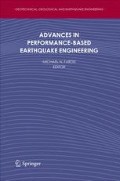Abstract
An improved performance assessment methodology aimed at estimating economic losses produced by earthquake ground motions in individual buildings is presented. The enhanced methodology permits the estimation of expected losses in the building at specific level of ground motion intensity, expected annual losses as well as estimating the mean annual frequency of occurrence of specific levels of economic losses. Unlike previous work, the proposed methodology explicitly accounts for economic losses resulting from the possibility of having to demolish the building after a seismic event. The probability of demolition is computed as a function of peak residual lateral deformations experienced in the building. The proposed approach is illustrated by estimating economic losses in two reinforced concrete moment resisting frame buildings design according to current seismic provisions and assumed to be located in Los Angeles, California. Results from this study indicate that, over a wide range of ground motion intensities, ductile buildings are more likely to experience large residual deformations leading to demolition than experiencing a collapse. Thus, neglecting the possible demolition leads to significant underestimation of economic losses.
Access this chapter
Tax calculation will be finalised at checkout
Purchases are for personal use only
References
Aslani H, Miranda E (2005a) Probabilistic earthquake loss estimation and loss disaggregation in buildings, report no. 157. John A. Blume Earthquake Engineering Center, Stanford University, Stanford, CA
Haselton CB, Deierlein GG (2007) Assessing seismic collapse safety of modern reinforced concrete frame buildings, technical report no. 156. John A. Blume Earthquake Engineering Center, Stanford University, Stanford, CA
Ibarra LF, Medina RA, Krawinkler H (2005) Hysteretic models that incorporate strength and stiffness deterioration. Earthq Eng Struct Dyn 34(12):1489–1511
Kawashima K (2000) Seismic design and retrofit of bridges. Proceedings of the 12th world conference on earthquake engineering, paper 2828, Auckland
Krawinkler H, Miranda E (2004) Performance-based earthquake engineering. In: Borzognia Y, Bertero V (ed) Earthquake engineering: from engineering seismology to performance-based engineering, 1st edn. CRC Press, Boca Raton, FL, pp 9-1–9-59
MacRae GA, Kawashima K (1997) Post-earthquake residual displacements of bilinear oscillators. Earthq Eng Struct Dyn 26:701–716
Mahin SA, Bertero VV (1981) An evaluation of inelastic seismic design spectra. J Struct Eng 107(ST9):1777–1795
Miranda E, Aslani H, Taghavi S (2004) Assessment of seismic performance in terms of economic losses. Proceedings of an international workshop on performance-based seismic design: concepts and implementation, Bled, Slovenia, pp 149–160
Mitrani-Reiser J, Beck J (2007) An ounce of prevention: probabilistic loss estimation for performance-based earthquake engineering. Department of Civil Engineering and Applied Mechanics, California Institute of Technology, Pasadena, CA
Pampanin S, Christopoulos C, Priestley MJN (2002) Residual deformations in the performance-seismic assessment of frame structures. Research Report No. ROSE-2002/02. European School for Advanced Studies in Reduction of Seismic Risk, Pavia, Italy
PEER (2006) OpenSEES (Open System for Earthquake Engineering Simulation). Retrieved May 2007, from Pacific Earthquake Engineering Research Center. opensees.berkeley.edu.
Porter KA, Kiremidjian AS (2001) Assembly-based vulnerability of buildings and its uses in seismic performance evaluation and risk management decision-making, Technical Report No. 309. John A. Blume Earthquake Engineering Center, Stanford University, Stanford, CA
Ramirez CM, Miranda E (2009) Building-specific loss estimation methods & tools for simplified performance-based earthquake engineering, Technical Report No. 173. John A. Blume Earthquake Engineering Center, Stanford University, Stanford, CA
Rosenblueth E, Meli R (1986) The 1985 Mexico earthquake: causes and effects in Mexico City. Concrete International 8(5):23–34
Ruiz-Garcia J, Miranda E (2005) Performance-based assessment of existing structures accounting for residual displacements, Technical Report No. 153. John A. Blume Earthquake Engineering Center, Stanford University, Stanford, CA
Ruiz-Garcia J, Miranda E (2006). Residual displacement ratios for assessment of existing structures. Earthq Eng Struct Dyn 35:315–335
Acknowledgements
The work described herein was supported by the Pacific Earthquake Engineering Research (PEER) Center with support from the Earthquake Engineering Research Centers Program of the National Science Foundation under Award No. EEC-9701568 and by the John A. Blume Earthquake Engineering Center at Stanford University. Incremental dynamic analyses were conducted by Curt Haselton. The loss estimates computed in the example were computed by Dr. Marc Ramirez.
Author information
Authors and Affiliations
Corresponding author
Editor information
Editors and Affiliations
Rights and permissions
Copyright information
© 2010 Springer Netherlands
About this chapter
Cite this chapter
Miranda, E. (2010). Enhanced Building-Specific Seismic Performance Assessment. In: Fardis, M. (eds) Advances in Performance-Based Earthquake Engineering. Geotechnical, Geological and Earthquake Engineering, vol 13. Springer, Dordrecht. https://doi.org/10.1007/978-90-481-8746-1_17
Download citation
DOI: https://doi.org/10.1007/978-90-481-8746-1_17
Published:
Publisher Name: Springer, Dordrecht
Print ISBN: 978-90-481-8745-4
Online ISBN: 978-90-481-8746-1
eBook Packages: Earth and Environmental ScienceEarth and Environmental Science (R0)

